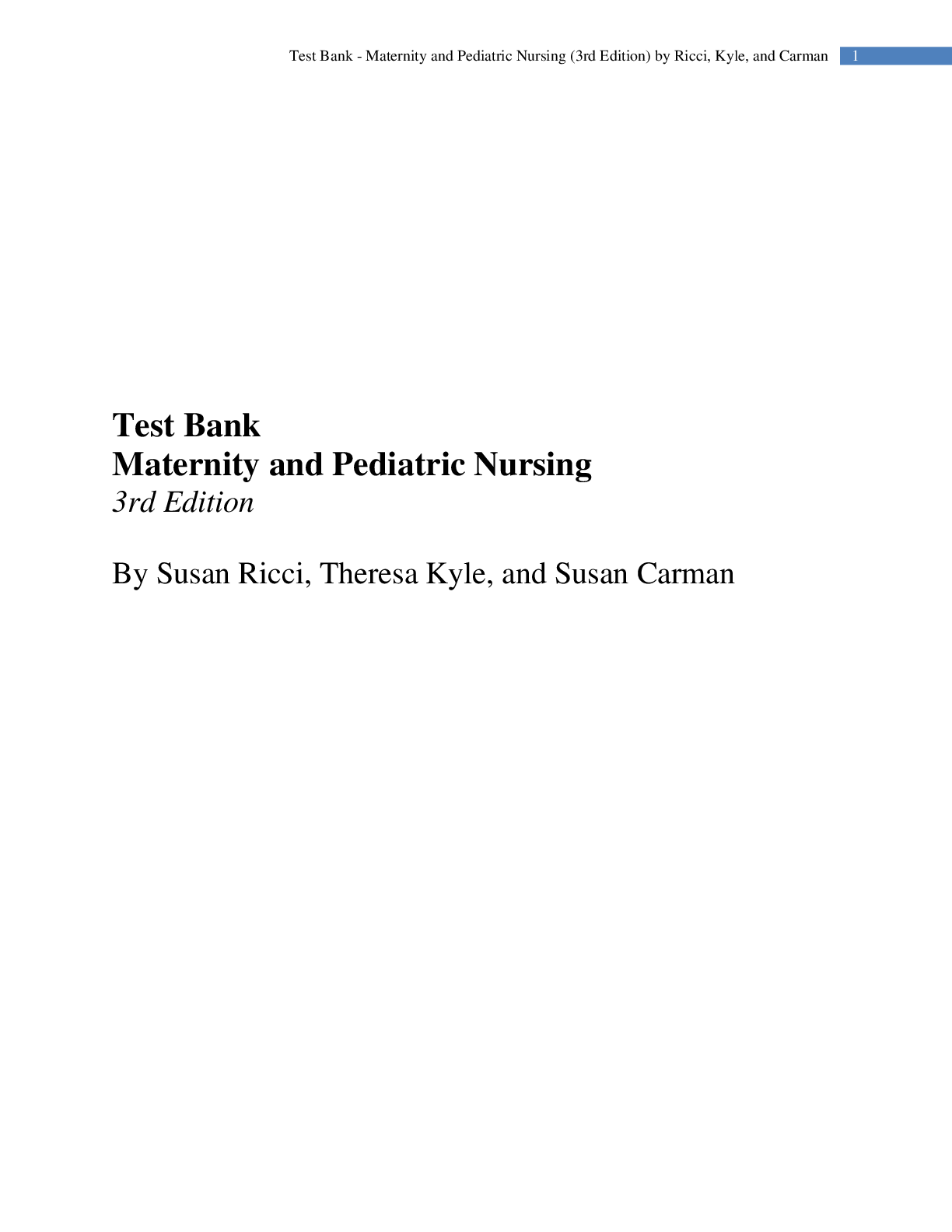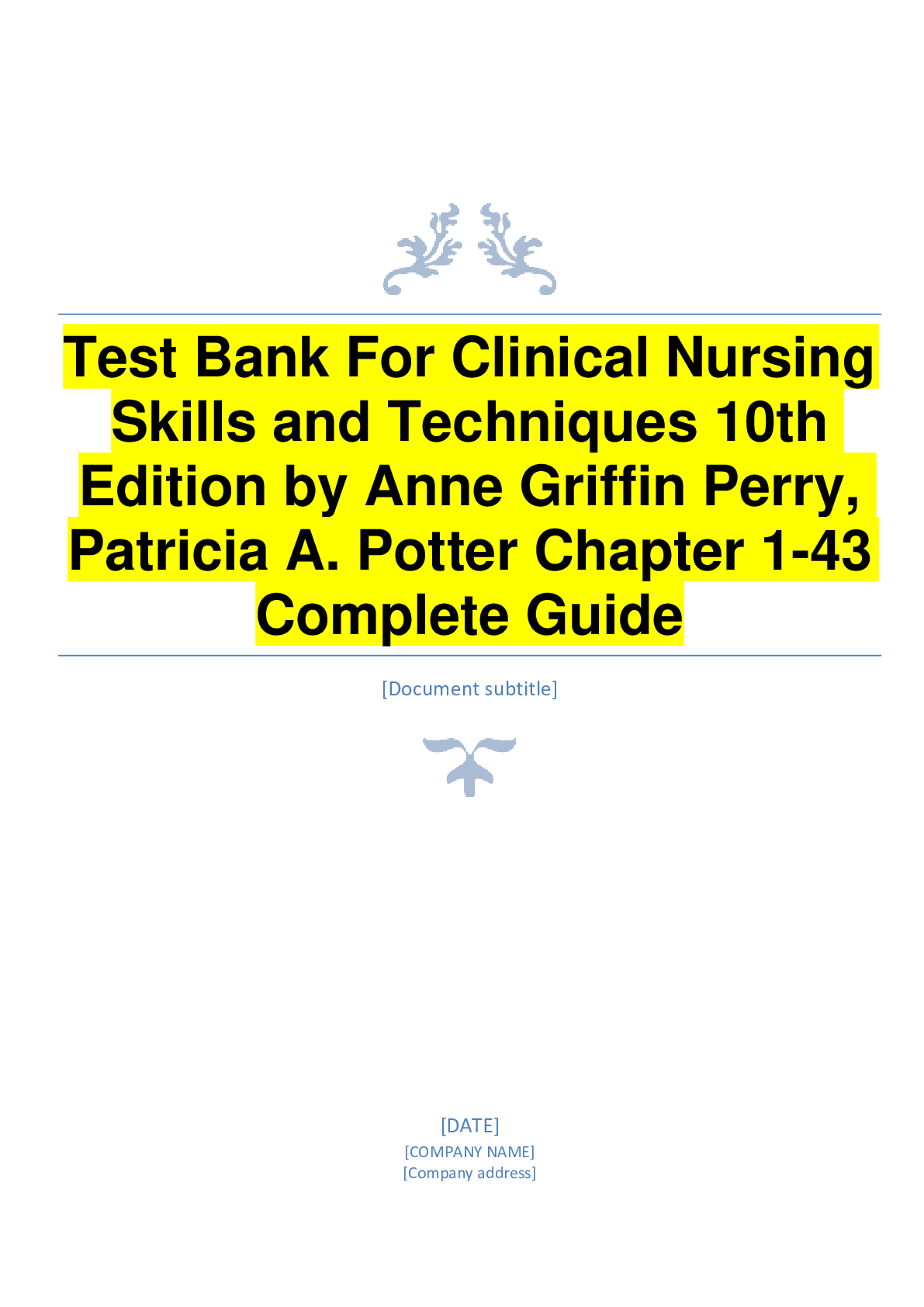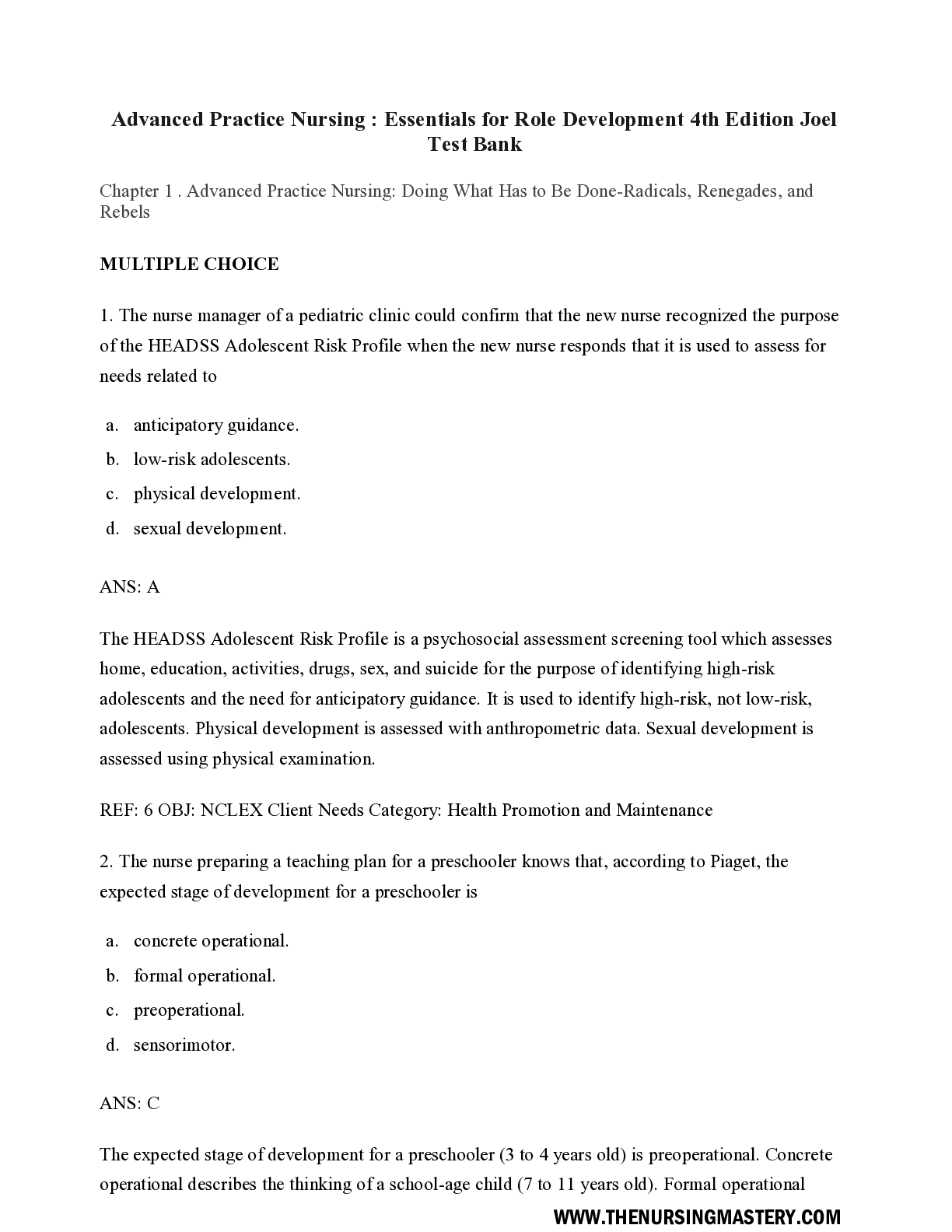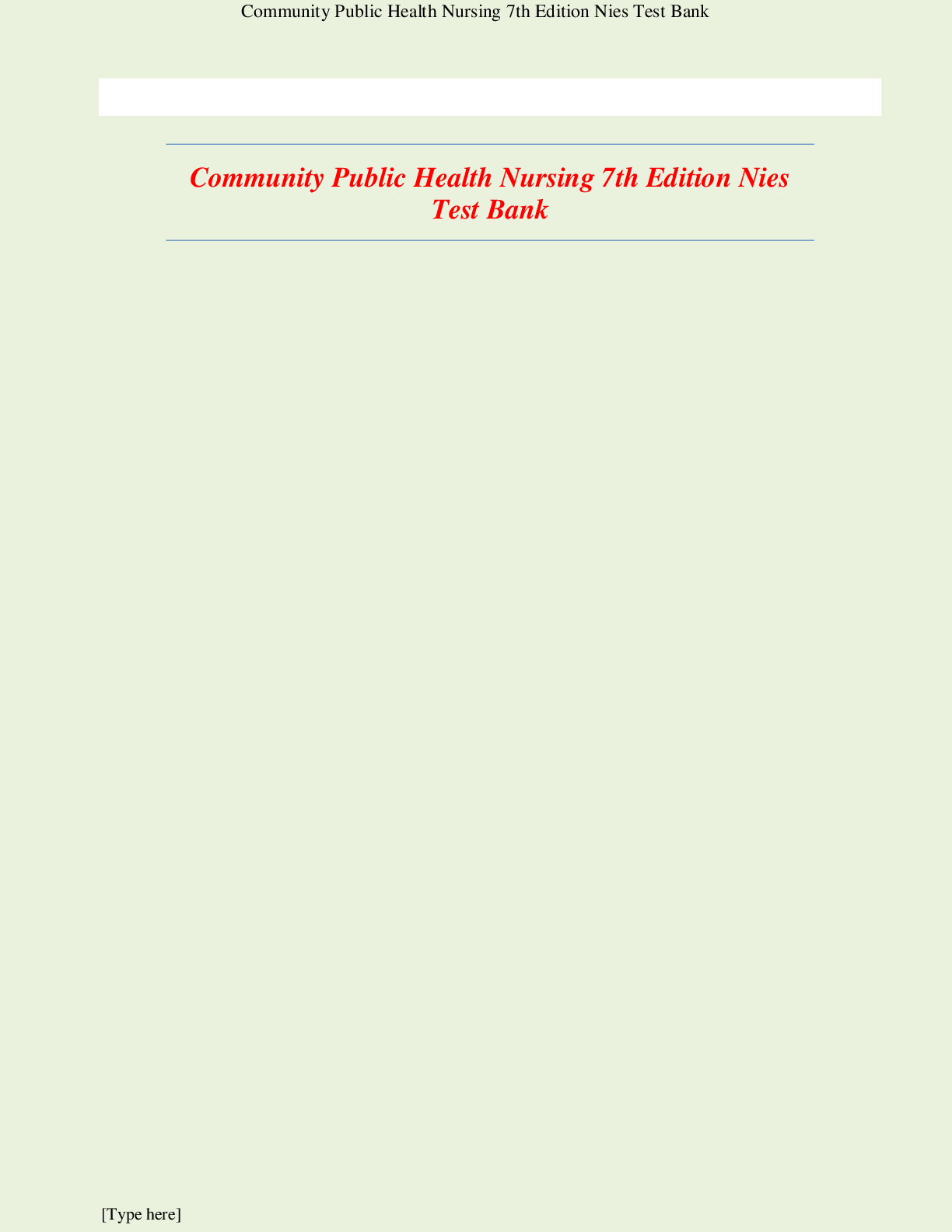TEST BANK BRUNNER SUDDARTH MEDICAL SURGICAL 14TH HINKLE - 2021
Document Content and Description Below
TEST BANK BRUNNER SUDDARTH MEDICAL SURGICAL 14TH HINKLE - 2021.Table of Contents Table of Contents 1 Chapter 01: Health Care Delivery and Evidence-Based Nursing Practice 3 Chapter 02: Community-Ba... sed Nursing Practice 22 Chapter 03: Critical Thinking, Ethical Decision Making and the Nursing Process 41 Chapter 04: Health Education and Promotion 64 Chapter 05: Adult Health and Nutritional Assessment 83 Chapter 06: Individual and Family Homeostasis, Stress, and Adaptation 104 Chapter 07: Overview of Transcultural Nursing 124 Chapter 08: Overview of Genetics and Genomics in Nursing 144 Chapter 09: Chronic Illness and Disability 164 Chapter 10: Principles and Practices of Rehabilitation 183 Chapter 11: Health Care of the Older Adult 220 Chapter 12: Pain Management 240 Chapter 13: Fluid and Electrolytes: Balance and Disturbance 260 Chapter 14: Shock and Multiple Organ Dysfunction Syndrome 280 Chapter 15: Management of Patients with Oncologic Disorders 300 Chapter 16: End-of-Life Care 319 Chapter 17: Preoperative Nursing Management 338 Chapter 18: Intraoperative Nursing Management 357 Chapter 19: Postoperative Nursing Management 376 Chapter 20: Assessment of Respiratory Function 396 Chapter 21: Respiratory Care Modalities 415 Chapter 22: Management of Patients With Upper Respiratory Tract Disorders 434 Chapter 23: Management of Patients with Chest and Lower Respiratory Tract Disorders 453 Chapter 24: Management of Patients With Chronic Pulmonary Disease 472 Chapter 25: Assessment of Cardiovascular Function 490 Chapter 26: Management of Patients With Dysrhythmias and Conduction Problems 508 Chapter 27: Management of Patients With Coronary Vascular Disorders 526 Chapter 28: Management of Patients With Structural, Infectious, and Inflammatory Cardiac Disorders 545 Chapter 29: Management of Patients With Complications from Heart Disease 564 Chapter 30: Assessment and Management of Patients With Vascular Disorders and Problems of Peripheral Circulation 582 Chapter 31: Assessment and Management of Patients With Hypertension 601 Chapter 32: Assessment of Hematologic Function and Treatment Modalities 620 Chapter 33: Management of Patients With Nonmalignant Hematologic Disorders 638 Chapter 34: Management of Patients With Hematologic Neoplasms 656 Chapter 35: Assessment of Immune Function 674 Chapter 36: Management of Patients With Immune Deficiency Disorders 692 Chapter 37: Assessment and Management of Patients With Allergic Disorders 710 Chapter 38: Assessment and Management of Patients With Rheumatic Disorders 728 Chapter 39: Assessment of Musculoskeletal Function 746 Chapter 40: Musculoskeletal Care Modalities 764 Chapter 41: Management of Patients With Musculoskeletal Disorders 782 Chapter 42: Management of Patients With Musculoskeletal Trauma 800 Chapter 43: Assessment of Digestive and Gastrointestinal Function 819 Chapter 44: Digestive and Gastrointestinal Treatment Modalities 837 Chapter 45: Management of Patients with Oral and Esophageal Disorders 855 Chapter 46: Management of Patients with Gastric and Duodenal Disorders 874 Chapter 47: Management of Patients With Intestinal and Rectal Disorders 893 Chapter 48: Assessment and Management of Patients with Obesity 911 Chapter 49: Assessment and Management of Patients with Hepatic Disorders 921 Chapter 50: Assessment and Management of Patients with Biliary Disorders 940 Chapter 51: Assessment and Management of Patients with Diabetes 959 Chapter 52: Assessment and Management of Patients with Endocrine Disorders 978 Chapter 53: Assessment of Kidney and Urinary Function 996 Chapter 54: Management of Patients with Kidney Disorders 1015 Chapter 55: Management of Patients with Urinary Disorders 1034 Chapter 56: Assessment and Management of Patients With Female Physiologic Processes 1054 Chapter 57: Management of Patients with Female Reproductive Disorders 1072 Chapter 58: Assessment and Management of Patients with Breast Disorders 1091 Chapter 59: Assessment and Management of Patients With Male Reproductive Disorders 1110 Chapter 60: Assessment of Integumentary Function 1129 Chapter 61: Managements of Patients with Dermatologic Problems 1147 Chapter 62: Managements of Patients with Burn Injury 1165 Chapter 63: Assessment and Management of Patients with Eye and Vision Disorders 1184 Chapter 64: Assessment and Management of Patients with Hearing and Balance Disorders 1203 Chapter 65: Assessment of Neurologic Function 1221 Chapter 66: Management of Patients with Neurologic Dysfunction 1239 Chapter 67: Management of Patients with Cerebrovascular Disorders 1257 Chapter 68: Management of Patients with Neurologic Trauma 1276 Chapter 69: Management of Patients with Neurologic Infections, Autoimmune Disorders, and Neuropathies 1294 Chapter 70: Management of Patients With Oncologic or Degenerative Neurologic Disorders 1312 Chapter 71: Management of Patients With Infectious Diseases Chapter 72: Emergency Nursing Chapter 73: Terrorism, Mass Casualty, and Disaster Nursing 1331 1349 1367 Chapter 01: Health Care Delivery and Evidence-Based Nursing Practice 1. The public health nurse is presenting a health promotion class to a group of new mothers. How should the nurse best define health? A) Health is being disease free. B) Health is having fulfillment in all domains of life. C) Health is having psychological and physiological harmony. D) Health is being connected in body, mind, and spirit. Ans: D Feedback: The World Health Organization (WHO) defines health in the preamble to its constitution as a state of complete physical, mental, and social well-being and not merely the absence of disease and infirmity. The other answers are incorrect because they are not congruent with the WHO definition of health. 2. A nurse is speaking to a group of prospective nursing students about what it is like to be a nurse. What is one characteristic the nurse would cite as necessary to possess to be an effective nurse? A) Sensitivity to cultural differences B) Team-focused approach to problem-solving C) Strict adherence to routine D) Ability to face criticism Ans: A Feedback: To promote an effective nurse-patient relationship and positive outcomes of care, nursing care must be culturally competent, appropriate, and sensitive to cultural differences. Team-focused nursing and strict adherence to routine are not characteristics needed to be an effective nurse. The ability to handle criticism is important, but to a lesser degree than cultural competence. 3. With increases in longevity, people have had to become more knowledgeable about their health and the professional health care that they receive. One outcome of this phenomenon is the development of organized self-care education programs. Which of the following do these programs prioritize? A) Adequate prenatal care B) Government advocacy and lobbying C) Judicious use of online communities D) Management of illness Ans: D Feedback: Organized self-care education programs emphasize health promotion, disease prevention, management of illness, self-care, and judicious use of the professional health care system. Prenatal care, lobbying, and Internet activities are secondary. 4. The home health nurse is assisting a patient and his family in planning the patients return to work after surgery and the development of postsurgical complications. The nurse is preparing a plan of care that addresses the patients multifaceted needs. To which level of Maslows hierarchy of basic needs does the patients need for self-fulfillment relate? A) Physiologic [Show More]
Last updated: 1 year ago
Preview 1 out of pages
Instant download

Buy this document to get the full access instantly
Instant Download Access after purchase
Add to cartInstant download
Reviews( 0 )
Document information
Connected school, study & course
About the document
Uploaded On
Feb 12, 2021
Number of pages
Written in
Additional information
This document has been written for:
Uploaded
Feb 12, 2021
Downloads
0
Views
5

.png)


.png)












